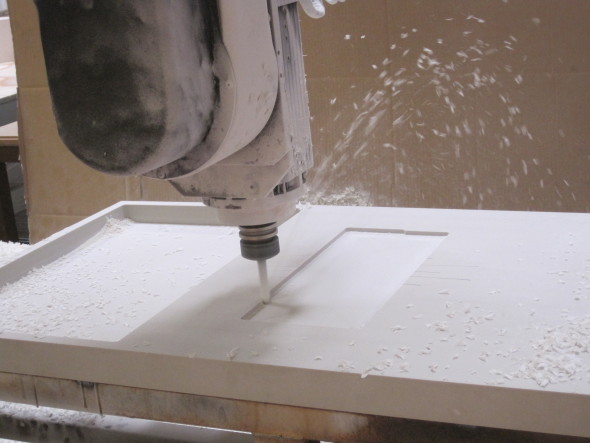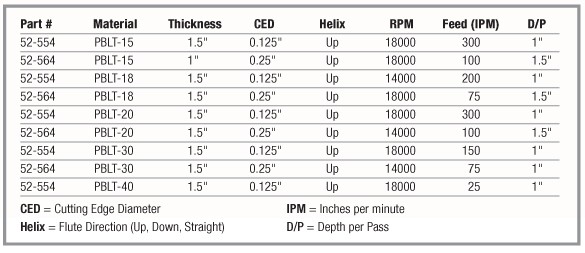
HDU Machining with Precision Board Plus
One of the more frequent inquiries we receive at Coastal Enterprises involves questions about machining Precision Board Plus HDU. For those that are experienced in working with the product, we typically hear things like, “this stuff cuts like butter” ,“my cutters last longer”, “I can set my CNC to a higher feed rate” or our favorite, “I get more chips and less dust”. Of course we remind these customers that these performance factors are the result of Precision Board Plus HDU being a non-abrasive cellular product that has no grain.
But if you’ve never used the product, you may want to know “what type of cutter works best” and “where do I start with my speed and feed settings”? First of all, a wide variety of HSS cutters commonly used for wood and plastics work very well for machining Precision Board Plus HDU, and a wide range of settings will produce great results.
Initial Setup
As a starting point, consider the testing done by cutter manufacturer Onsrud on various densities of Precision Board Plus HDU. Using a carbide double-edge upcut spiral 0.125” cutter with PBLT-18 (18lb. density), best results were achieved with an RPM of 14,000, a feed rate of 200 IPM, at a depth of 1” per pass. Similarly good results were achieved using a carbide double-edge upcut 0.25” cutter spinning at 18,000 RPM, with a feed rate of 75 IPM at a depth of 1.5” per pass. Both settings produced a smooth surface finish.
Keep in mind that while this data was generated with carbide cutters, HSS cutters also perform very well due to the non-abrasive nature of Precision Board Plus HDU. Adam Prentiss of Lormac Plastics has extensive experience machining Precision Board Plus HDU, particularly PBLT-30 and PBLT-40. He finds dialing in the right speed and feed very easy with both HSS and carbide cutters.
Here are settings used by Onsrud that produced the best results across a range of Precision Board Plus densities. These and other data for machine settings for a variety of materials can be found at www.plasticrouting.com
Chip Load
Remember it’s always a good idea to optimize your chip load by setting your feed rate and cutter speed to yield the largest chip that produces the desired surface finish. While Precision Board Plus HDU does not conduct heat and is non-abrasive, this will ensure that heat is carried away from the cutter, prolonging tool life. Onsrud reminds us of this useful formula:
Chip Load = Feed rate/ RPM x # of flutes
To increase chip load:
- Increase feed rate
- Decrease RPM
- Use a cutter with fewer flutes
To decrease chip load:
- Decrease feed rate
- Increase RPM
- Use a cutter with more flutes
With a little experimentation you’ll become an expert at HDU machining with Precision Board Plus in no time. Proper cutter selection and machine setup will produce a smooth cut, leaving chips that fall to the ground and do not become airborne. And because we’ve added an anti-static agent to Precision Board Plus, chips will not cling to your work or your equipment.
Did You Know?
Precision Board Plus Precision Board Plus does not out-gas during the autoclave curing process, so it’s ideal for prepreg layup tools and mold patterns (see autoclave ramping procedures). To learn more about the capabilities of Precision Board Plus, view or download our product data sheets.
Need help with a quote? Click here or call us at 800-845-0745
